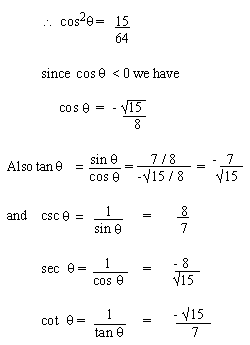|
4.1 Fundamental Identities

Click here to enlarge
Unfortunately no standard (or general) method of
proof of identities exists which works for all identities. However,
here is a list of some hints or general rules or strategies that
we can suggest.
- Work with more complicated side (if there is one) till it matches
the second side.
- If you are unable to reduce one side to the other,
use the fundamental identities (1) and (2) to change eveything
into sines and cosines.
- Apply the Pythagorean identities i.e. sin2
 + cos2
+ cos2  = 1 or the other forms
= 1 or the other forms
cos 2  = 1 - sin2
= 1 - sin2  = ( 1 + sin
= ( 1 + sin  ) (1 - sin
) (1 - sin  ), ),
sin2  = 1 - cos 2
= 1 - cos 2  = ( 1 + cos
= ( 1 + cos  ) (1 - cos
) (1 - cos  ),
),
sec2  - tan2
- tan2  = 1 or (sec
= 1 or (sec  + tan
+ tan  ) (sec
) (sec  - tan
- tan  )
=1 etc. )
=1 etc.
- Above all, at evey step keep your eye on the expression
that you want to end with this only dictates your ways of proving
the identities.
SOLVED EXAMPLES : (Type - I)
Example 1 If  find csc
find csc  , tan , tan  , cot
, cot  and and 
Solution
We know that 3p/2 <
 < 2 p
i.e, 2700 < < 2 p
i.e, 2700 <  0
< 3600 i.e. 0
< 3600 i.e.  lies in the IV th Quadrant. Using `ASTC' sin
lies in the IV th Quadrant. Using `ASTC' sin  , csc
, csc  , tan , tan  and cot
and cot  are negatives.
only cos are negatives.
only cos  and sec and sec  are positive.
are positive.

Example 2 If sin  = 7 / 8, cos
= 7 / 8, cos  < 0
. Determine other 5 values of the trigonometric ratios. < 0
. Determine other 5 values of the trigonometric ratios.
Solution: sin2  + cos 2
+ cos 2 =
1 =
1


[next page]
|
Index
Trignometric
Identities
4.1
Fundamental Identities
4.2
The addition formulas
4.3 The multiple-angle (Double
& Half angle) formulas
4.4 Tangent Identities
4.5 Factorization & Defactorization
Supplementary Problems
Chapter
5
|